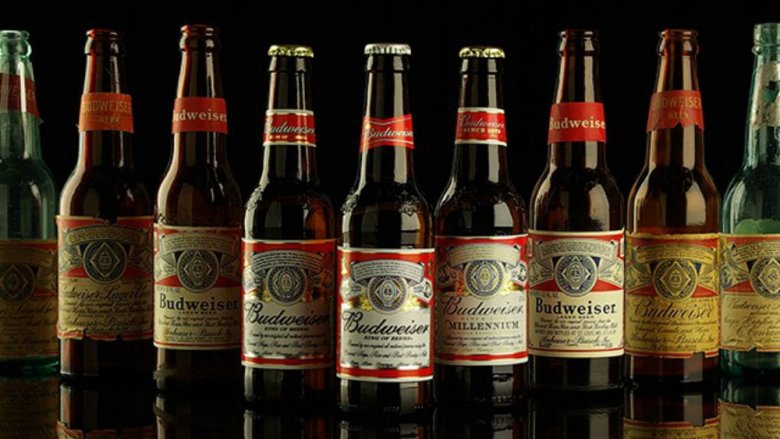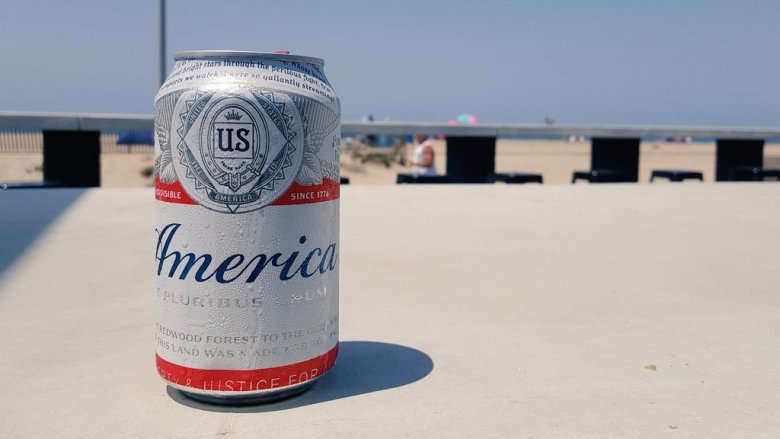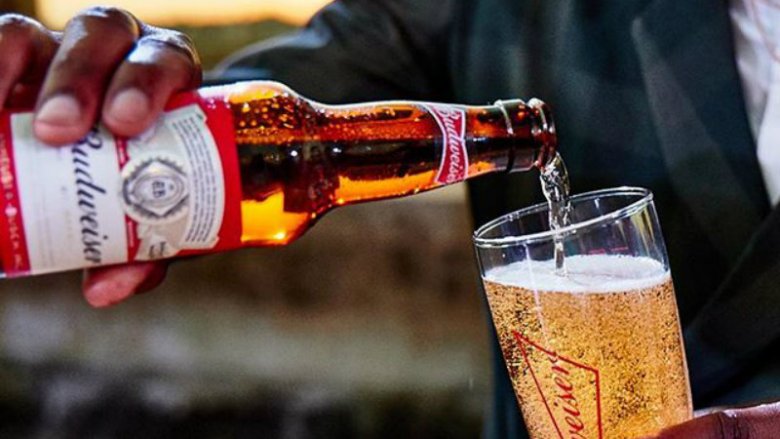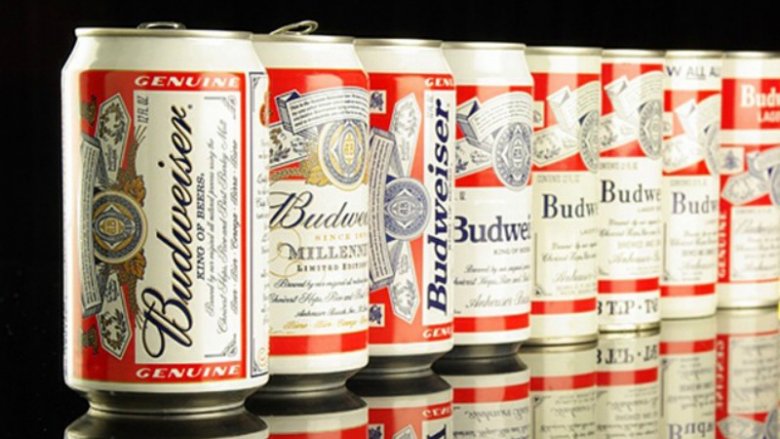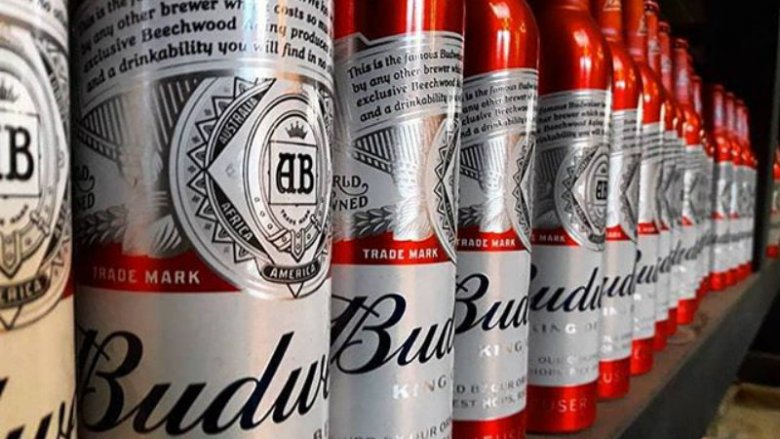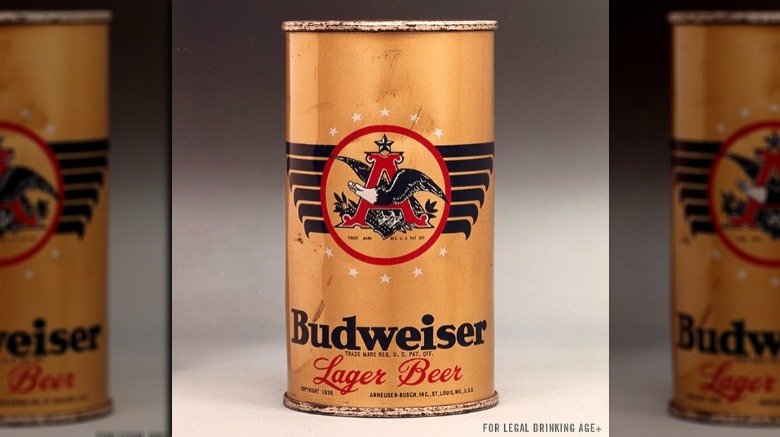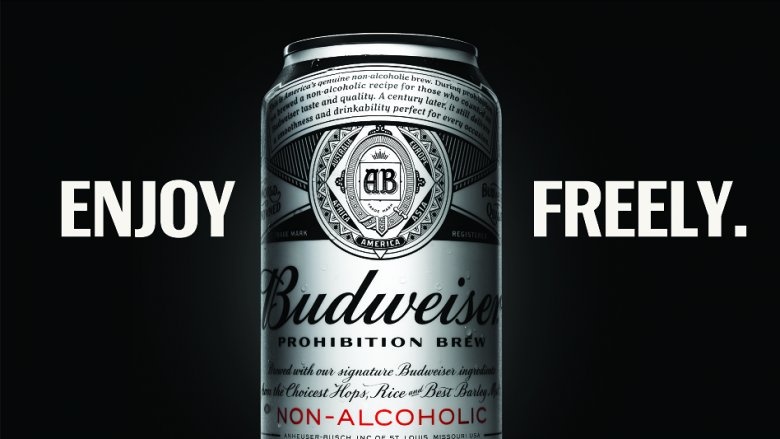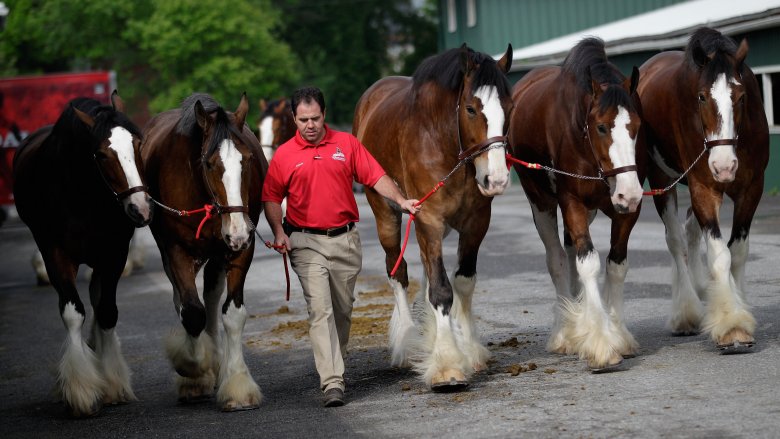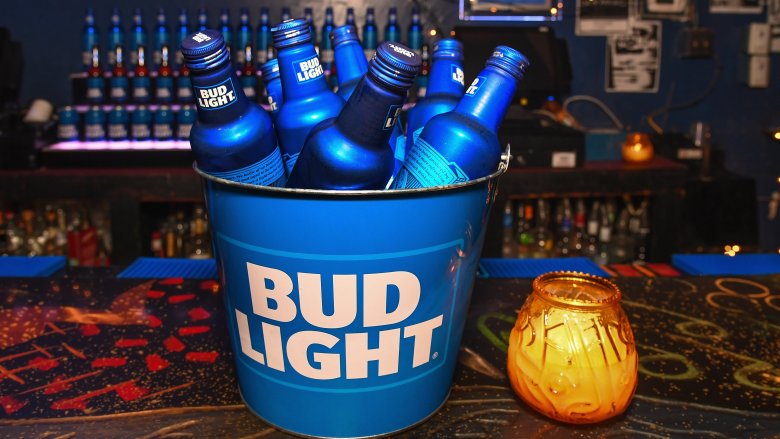The Untold Truth Of Budweiser
Country music. Apple pie. John Deere tractors. Budweiser beer. There are certain things that are just quintessentially American. Despite the growing craft beer movement in this country, we still associate drinking Budweiser beer with one of the most familiar icons of Americana.
We know what it tastes like (light, fizzy, unmemorable), and we cheer on their successful marketing campaigns — especially during the Super Bowl — with those adorable puppies and beautiful horses.
Whether you love it or hate it, Budweiser is a familiar piece of American culture. But we've rounded up some of the behind-the-scenes secrets about Budweiser that you may have never heard of, from the beer's recently-revealed secret recipe (and the surprising secret ingredient), to its surprising origins and some of the secrets behind the Clydesdale horses.
Keep reading to find out some of the most fascinating secrets and little-known facts behind one of the most popular beers in the world.
Budweiser is not American
One of the most successful marketing campaigns in the world has convinced us that Budweiser is as American as apple pie. Well, news flash: Both are actually German. Budweiser started out as the dream of a German immigrant, Adolphus Busch (yes, that Busch, of the Anheuser-Busch parent company). Busch immigrated from Germany to the United States in 1857 and settled in St. Louis. He started working for a brewery supply company and then joined forces with one of his clients, Abert Anheuser, to create a brewery specifically with the German population of St. Louis in mind.
You might think this inspiring immigrant, rags-to-riches backstory (which was featured in a 2017 Super Bowl commercial), made Anheuser-Busch even more All-American. But sadly, Budweiser is no longer even owned by an American company. Anheuser-Busch was sold to the Belgian company In-Bev in 2008, and the full name of Budweiser's parent company is now known as Anheuser-Busch InBev. The North American headquarters still remain in St. Louis, but most of the business decisions now happen in Belgium.
Budweiser's beer ancestor tasted disgusting
Budweiser's immigrant story is not the only interesting part of their past. The original beer from the makers of Budweiser was pretty gross. Although Both Adolphus Busch and Abert Anheuser started out in beer backgrounds — Busch as the owner of a brewery supply company and Anheuser as the owner of a brewery — Busch was decidedly the beer expert. Anheuser was a well-off soap manufacturer who came into ownership of a failing local brewery called the Bavarian Brewing Co.
In an interview with NPR, William Knoedelseder, the author of Bitter Brew: The Rise and Fall of Anheuser-Busch and America's King of Beer, said that the beer at the brewery was so bad that "people would spit it back across the bar at bartenders."
Thankfully, Anheuser and Busch joined forces, Busch applied his German beer expertise, they dropped that awful beer recipe, changed the name, and the failing Bavarian Brewing Co. became known as Anheuser-Busch.
There's a weird reason why all Bud tastes the same
Any food or beverage company knows that part of the secret to success is consistency. You might notice that every bottle or can of Budweiser tastes exactly the same (as it should). The secret to consistency across the brand and all 12 United States AB InBev breweries is that they all use the same yeast — derived from the same culture originally used by Adolphus Busch in the first batch of beer he brewed in the 1850s.
According to Fox News, the special yeast is shipped from St. Louis to all of the company's breweries across the country weekly, thereby assuring that each batch of beer produced will taste consistently the same, thanks to the special, centuries-old yeast. Budweiser confirmed this bit of information on its website, stating that the "30 billion or so yeast cells" in each bottle of Budweiser all descended from the same original culture.
Budweiser has a secret ingredient and it's not what you'd expect
Ancient yeast is not the only secret to getting Budweiser to taste consistent. Like most iconic beverages, Budweiser has a secret recipe. But ever since food and health personality Vani Hari, aka, "Food Babe," pressured AB InBev — among other major brewers — to release the ingredients they use in their beer in 2014, Budweiser has finally made its long-secret recipe available to the public. The beer consists of only five ingredients — most of which should not be too surprising to even the casual beer fan: Water, barley malt, hops, and yeast. But the fifth ingredient — rice — is a bit of a head-scratcher.
So, why rice? Budweiser says it gives their beer a "crisp taste and smooth finish," but critics of the brand claimed that the company used that as an excuse to dilute the beer because rice is cheaper to use than malted barley.
It was pasteurized before milk
Milk isn't the only beverage that requires pasteurization to survive storage and shipment. We may take it for granted that most macrobrewed beer is pasteurized, but Budweiser actually did it before anyone else. According to Anheuser-Busch's website, Adolphus Busch became the first brewer to use the (the little-known) pasteurization process to ship his beer safely without fear of spoiling in the 1870s — before pasteurizing milk was even a thing.
Busch was a real innovator. By the end of the 19th century, he had completely changed the way his beer was shipped: He introduced artificial refrigeration, refrigerated rail cars and rail-side ice houses, all to make his beer taste as fresh as possible once it got to the consumer — no matter how long the journey. These inventions made it a lot easier for Budweiser to grow from a St. Louis beer to a beer that was known from coast to coast.
They had a smart way of surviving Prohibition
Clearly, 1930's America was not a profitable time for alcohol businesses. As pre-Prohibition panic set in, Anhuser-Busch tried to offset the anti-liquor movement by debuting ads that portrayed their beer as "light and happy." When that did not work and the United States pulled the plug on alcohol sales in America, Anheuser-Busch thought quickly.
They survived the dark days of Prohibition by selling the raw ingredients in beer (since selling the full product was now illegal). According to NPR, Busch's son, August Anheuser-Busch, actually came up with the idea.
"It wasn't illegal to sell the ingredients, it was illegal to assemble them," William Knoedelseder told NPR. "Their yeast profits saved the company. That was the cash engine that was able to keep the company open."
The smart idea did more than just keep the Anheuser-Busch business afloat — following Prohibition, most of their competition was wiped out.
Clydesdale horses go through a rigorous interview process
We're all familiar with the bastions of the Budweiser marketing department: the Clydesdale horses. But did you know that it takes a lot for a horse to actually become a Budweiser Clydesdale? Yes, there's an "interview process."
The Budweiser Clydesdales have been a tradition since 1933 when August and Adolphus Busch Jr. surprised their father with a six-horse Clydesdale hitch. Their father was so moved he cried (that's where the phrase "crying in your beer" came from) and the horses became a mainstay of the company.
These days, Budweiser breeds the Clydesdale horses and has about 175 in the herd total. To be considered a Budweiser Clydesdale horse, the animals must be aesthetically consistent: "They must stand at least 18 hands high (or 6 feet tall). They must be geldings and at least 4 years old. They must have a bay coat, four white stockings, a blaze of white on the face, a black mane and a black tail. And they must weigh between 1,800 and 2,300 pounds," according to Warm Springs Ranch in Missouri, the home of the Budweiser Clydesdales.
It's not the King of Beers anymore
We may think of Budweiser as one of the most famous and popular beers in America, but in actuality, the beer is only the fourth-best-selling beer in the country, behind its younger brother, Bud Light (at number one), Coors Light (at number two) and Miller Light (at number three), according to Statista.
In fact, according to Vine Pair, Bud Light has been more popular than Budweiser since 2001, and it was only just introduced in 1988. Other big beer competitors aren't the only ones Budweiser has to worry about: According to Paste Magazine, craft beer as a unit outsold Budweiser for the first time ever in 2014. At the same time, Anheuser-Busch admitted 44 percent of 21-27 year old drinkers have never even tried Budweiser. They still churn out millions of barrels of beer every year, but the brand doesn't have quite the same grip in the nation as it did in the "good old days."
Budweiser had a video game in the 1980s
Anyone that grew up in the 1980s might remember the fun little arcade game called Tapper, where players take on the role of a busy bartender trying to fill the beer steins of thirsty customers.
The game released in 1983 was actually sponsored by Budweiser, and the bar featured the Budweiser logo. Tapper was originally supposed to be sold to bars as a fun game for bar patrons, but the arcade was rebranded in 1984 as Rootbeer Tapper. It was rebranded as a "dry" game because it would otherwise be considered marketing alcohol to minors.
According to Paste Magazine, in the bonus levels, the bartender will shake a lineup of cans of beer, and you have to guess the correct one. The wrong one will spray you, while the right beer can will reward you with a drink and a message, "This Bud's for you!"
Miss the good ol' days of beer-centric video games? Check out Tapper's cameo in Wreck it Ralph.
